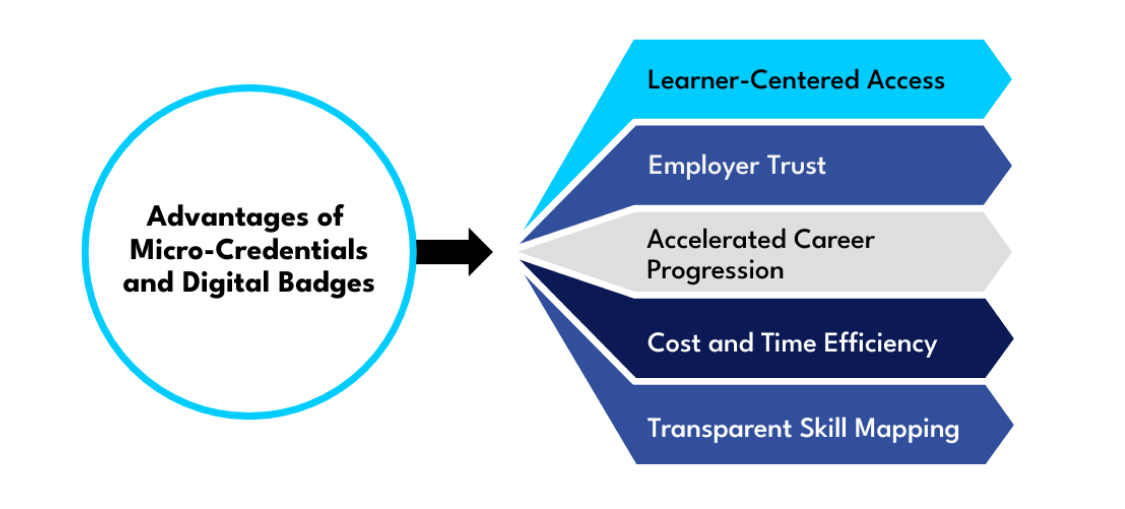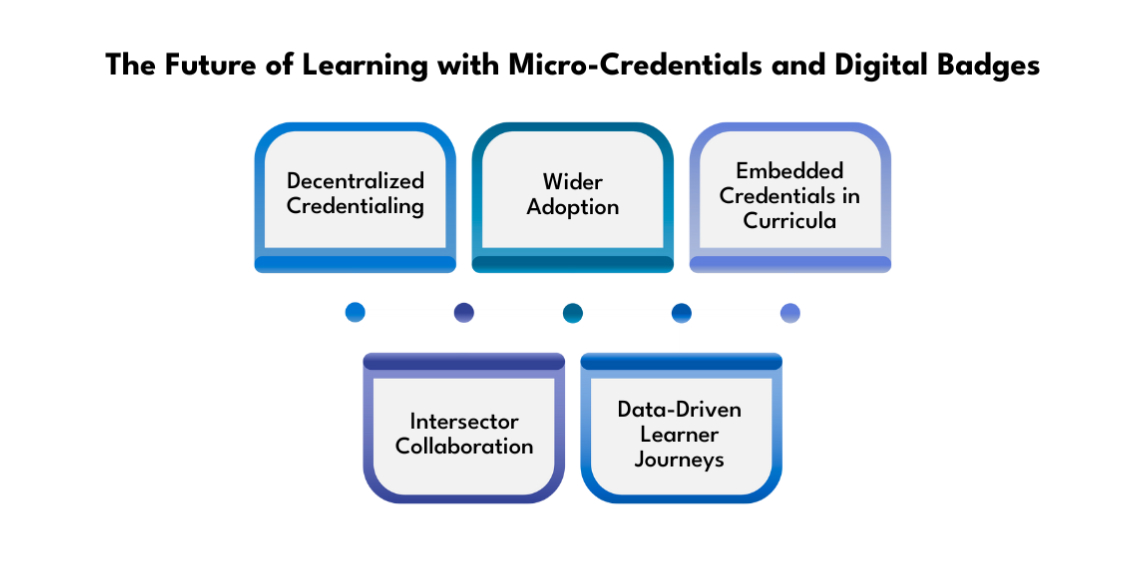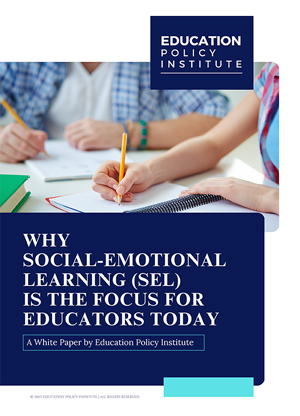In today’s fast-evolving educational landscape, learning is no longer defined solely by traditional degree programs. Micro-credentials and digital badges are emerging as flexible, skills-focused alternatives. These compact, verifiable credentials capture specific competencies and can be earned more quickly than traditional qualifications—often online and aligned to workforce or personal interests. As learners seek meaningful recognition for discrete skills, these credentials have begun transforming learning, motivation, and career trajectories.
What are Micro-Credentials and Digital Badges
Micro-credentials are short, competency-based certifications that concentrate on distinct skills or knowledge areas. They typically require weeks or a few months of focused study. When awarded, they often come in the form of digital badges—portable tokens embedded with metadata that verify the issuing criteria, date earned, and evidence of learning. These badges can be displayed on resumes, professional profiles, or shared across networks, enabling learners to prove mastery of specific abilities.
Digital badges carry more than just a symbol of completion—they encapsulate metadata that describes what was learned and how it was assessed. As digital credentials, they are destination-agnostic, meaning they can be publicly shared and automatically verified online—unlike paper certificates that require human validation.
Why They’re Gaining Popularity
The rising popularity of micro-credentials and badges is tied to changes in how people learn and work. These compact credentials meet the growing demand for flexible, accessible, and targeted education options.
- Growing Demand for Specific Skills: Employers increasingly seek precise competencies and short-term training. Micro-credentials enable learners to quickly build relevant expertise aligned with evolving job requirements, addressing skill gaps more effectively than traditional programs.
- Accessibility and Flexibility: Many learners value affordable, self-paced programs. These credentials offer learning opportunities that can fit around work or other commitments, allowing people from different backgrounds to access and complete skill-based education.
- Stackable Learning: Learners can accumulate multiple credentials over time, combining them into broader knowledge areas—similar to assembling a collage of expertise. This modular approach allows for progressive skill-building and long-term growth.
Motivation and Engagement through Badges
Badges don’t just recognize achievements—they can also inspire them. Learners often stay more engaged when they have visible milestones and recognition along the way. Digital badges play several motivational roles:
- Goal Setting and Recognition: Badges help learners visualize milestones in their progress and reward them for specific achievements. They serve as micro-rewards that make the learning journey more tangible and motivating.
- Gamified Engagement: When used thoughtfully, badges mirror game mechanics like progress levels or leaderboards, enhancing engagement. This game-like system can encourage students to complete more challenges and pursue continuous improvement.
- Visibility of Hidden Skills: They make informal or non-traditional learning visible skills that often go unrecognized in standard transcripts. Badges can showcase everything from leadership abilities to technical proficiencies acquired outside traditional classrooms.
Learning Benefits and Skill Validation
Micro-credentials and badges not only mark progress but actively improve the learning process. Their structure supports deeper understanding and clearer communication of skills.
- Focused Learning: Each credential addresses a specific skill or task with targeted instruction and assessment. This ensures students develop applicable, job-ready knowledge.
- Immediate Feedback: Learners often receive feedback on performance, allowing for rapid iteration and improvement. This loop enhances understanding and mastery.
- Career Signaling: Employers increasingly recognize these credentials as indicators of up-to-date, practical expertise. Earning and showcasing badges can boost employability by highlighting specific capabilities.
Integration into Learning Ecosystems
As micro-credentials become more recognized, they are being embedded into larger educational ecosystems. This supports both learners and institutions in achieving greater transparency and alignment.
- Portfolio Building: Students compile evidence of learning (projects, assessments, artifacts) linked with badges to build transparent, verifiable digital portfolios. These portfolios serve as a dynamic record of skills and accomplishments.
- Stackable Pathways: Multiple badges can combine to represent mastery in broader fields or competencies, mirroring traditional degree sequences. This stacking system supports both short-term goals and long-term educational progression.
- Interoperability: Many platforms rely on open badge standards, making credentials portable across systems and recognizable by employers and other institutions. This flexibility enhances their value in academic and professional settings.
Lifelong Learning and Career Agility
Micro-credentials and badges are shaping a future where education continues beyond traditional timelines. Their rise aligns with the evolving concept of lifelong learning—where individuals continually adapt to new roles, industries, and technologies.
- Support for Career Transitions: As industries change, individuals can earn targeted credentials to shift careers without restarting formal education. This supports mobility and adaptability.
- Continuous Skill Upgrades: With job requirements constantly evolving, micro-credentials provide a mechanism for learners to stay current in their fields. They offer quick routes to updating or expanding skill sets.
- Personalized Learning Journeys: Learners can chart their own path by selecting credentials that match their goals and interests. This individualized learning supports autonomy and empowerment.
Advantages of Micro-Credentials and Digital Badges
Beyond accessibility, these credentials bring numerous practical and strategic benefits to both students and their institutions. Here are several key educational and professional benefits:

- Learner-Centered Access: Short, focused, and flexible credentials allow self-directed learners to pursue areas of skill interest without committing to full degrees. This appeals to adult learners and professionals seeking to update specific competencies.
- Employer Trust: Verified badges backed by assessment metadata build credibility with recruiters and hiring managers. When aligned with real job roles, these credentials gain significant traction.
- Accelerated Career Progression: Targeted credentials help professionals upskill fast—boosting opportunities in competitive job markets. They provide quick pathways to job promotions or new career directions.
- Cost and Time Efficiency: Micro-credentials are often more affordable and quicker than degrees, expanding access across income levels and geographies. This makes them ideal for lifelong learners.
- Transparent Skill Mapping: Embedded metadata in badges offers clear information about what learners know and can do. This transparency supports informed hiring and career development decisions.
Challenges and Considerations
Despite their growing influence, micro-credentials face certain hurdles that need addressing for broader adoption and credibility.
- Credibility and Standards: Not all credentials are created equally—learners and employers must discern high-quality credentials from less rigorous offerings. This requires standardized evaluation frameworks.
- Oversupply of Badges: Inflated or meaningless badges (e.g., based on trivial achievements) dilute their value and confuse stakeholders. Ensuring rigor and relevance is critical.
- Verification and Fraud Risks: Without strong verification infrastructure (e.g., blockchain or digital signatures), badge authenticity can be questioned. This may hinder their acceptance.
- Uneven Recognition: Not all industries or employers accept micro-credentials as legitimate proof of skill, this varies by context and region. Greater awareness and endorsement are needed.
The Future of Learning with Micro-Credentials and Digital Badges
The potential for these credentials is vast. As technology evolves, they are likely to become foundational elements in personal and professional development. Looking ahead, several trends point toward broader impact:

- Decentralized Credentialing: Blockchain and decentralized identity technology can give learners greater ownership over credentials, making them portable and tamper-proof. This enhances trust and transparency.
- Wider Adoption: Numerous institutions are issuing digital badges—mainstream acceptance is accelerating. This growth is likely to continue as more learners seek flexible alternatives.
- Embedded Credentials in Curricula: Institutions may embed micro-credentials within broader courses and stack them toward degrees or certificates. This provides dual benefits of formal and informal recognition.
- Intersector Collaboration: Partnerships between employers, learning providers, and educators will help align credentials with real-world needs, boosting credibility and recognition.
- Data-Driven Learner Journeys: Rich badge metadata can feed dashboards showing skill progression, gaps, and learning pathways—helping both learners and institutions shape individualized goals.
Conclusion
Micro-credentials and digital badges are more than educational novelties—they are transforming how learning is designed, validated, and shared. By offering targeted, flexible, and verifiable proof of skill, they open pathways to career growth, lifelong learning, and academic innovation. As verification technology improves and standards evolve, these credentials will increasingly form the building blocks of modern learning ecosystems. In turn, learners gain control over their educational narrative with meaningful recognition for every step along the way.





